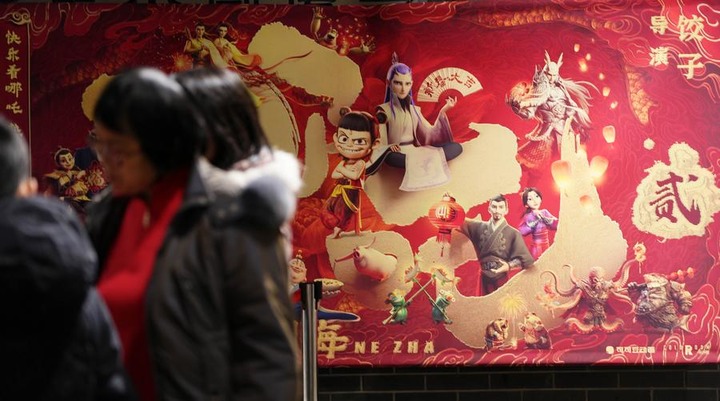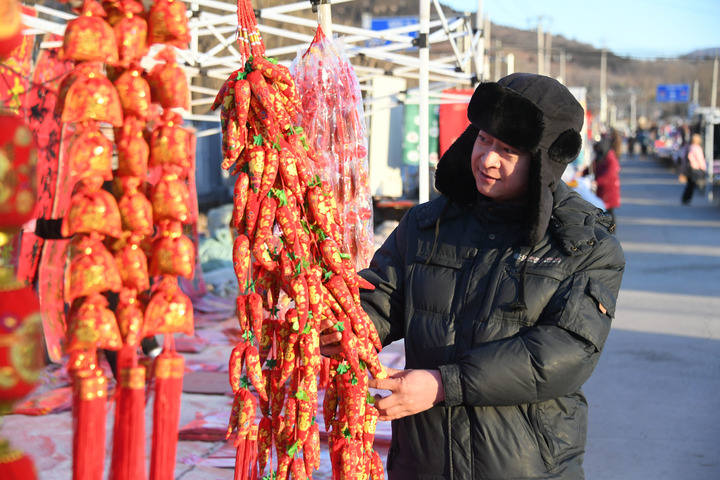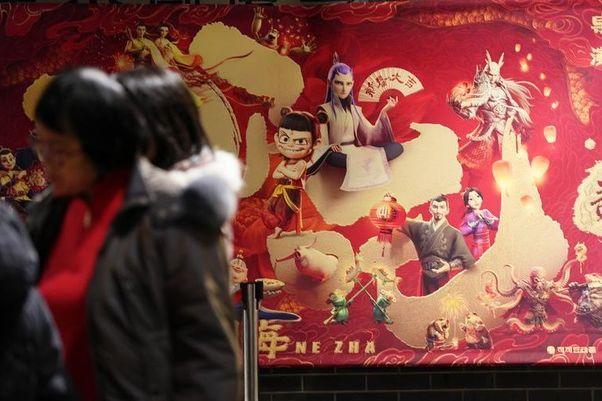
A poster of the animated feature "Ne Zha 2" is pictured at a cinema in Shenyang, northeast China's Liaoning Province, Feb. 6, 2025. (Xinhua/Li Gang)
BEIJING, Feb. 8 (Xinhua) -- New consumption trends are forming in China, as Chinese youth are prioritizing spending on goods that bring joy, experiences that can be shared, and items empowered by smart technology, according to report by People's Daily on Wednesday.
Young people are becoming a primary force of consumption, with their preferences and spending structures playing an ever-larger role in shaping the consumer market. Fueled by youth consumption, new growth drivers are appearing, injecting fresh dynamics into the consumer arena.
-- Prioritizing emotional value: paying for joy
"Do you have 'Ne Zha' series mystery boxes?" Ding Xian, a 25-year-old movie viewer fresh from watching the animated feature "Ne Zha 2", asked on February 2 at a pop-culture toy store at Huaxin Mall in Qingjiangpu District, Huai'an City, east China's Jiangsu Province.
"They were all sold out in one and a half days after went on sale. You'll have to wait for the restock," the salesperson informed her.
As an anime enthusiast, Ding Xian is willing to pay for her hobbies and goods that bring her joy. She took out a cola cup from her handbag, which featured a Ne Zha toy figure on the lid. "I didn't plan to buy cola, but when I saw this movie-themed merchandise at the cinema, I just couldn't resist purchasing it."
In recent years, shops specialized in selling "guzi", or goods created from copyrighted cultural works in domains such as animations, comics, games, and novels (ACGN), have seen increasing visits by young consumers.
"The majority of our customers are young people. During the Spring Festival holidays, we handle about 500 to 600 sales transactions each day," said Liu Yang, store manager of a "guzi" shop in the Huaxin Mall.
The ACGN consumers, mainly young enthusiasts, have demonstrated strong consumption intent and remarkable purchasing power. According to market consultancy iiMedia Research, China was home to 503 million pan-ACGN enthusiasts in 2024, with the market value of ACGN and derivative products surging to 597.7 billion yuan.
"Young people are the new major force of consumption we are targeting at," stated Xu Hongwei, who is in charge of the businesses of Huaxin Mall.
He added that young people's consumption mindset and preferences have evolved. They long for goods that not just meeting their functional requirements, but more importantly satisfying their emotional attachment.
To attract more youth, Huaxin Mall has brought in a large number of first stores in Huai'an District in sectors such as dining, fashion, and trendy toys. It has also set up an ACGN culture zone, significantly increasing the spending willingness of young consumers.
-- Highlighting social attributes: sharing on social media
Traditional markets have become photogenic spots for social media among the youth during this year's Spring Festival.
Thanks to self-media and short video platforms, young people can share images, videos, and live broadcasts from offline markets on social media, breaking the spatial constraints of traditional markets and drawing more youth to these fairs for on-site experiences and consumption.

Photo shows a traditional market in Kaoshanji Village, Jinhaihu Town in Beijing's Pinggu District on January 27. (Xinhua/Ren Chao)
The post-90s Zhang Liyuan went to a traditional market in Kaoshanji Village, Jinhaihu Town in her hometown of Pinggu District, Beijing. In the market, she saw a dazzling array of products, ranging from fabrics and clothes to locally produced fruits and vegetables, dried fruits, confections, seafood, and even imported cherries. She also enjoyed traditional opera performances, appreciated handicrafts and tasted authentic local snacks.
While strolling through the market, Zhang Liyuan captured scenes with her phone, snapping photos and recording videos. Shortly after she shared these images on popular Chinese social network and lifestyle-sharing platform Xiaohongshu, inquiries about the market's business hours began pouring in from curious netizens. "On social media platforms like Xiaohongshu and Douyin, an increasing number of young people are sharing their experiences at traditional markets," said Zhang Liyuan.
It's noted that Kaoshanji market is one of the oldest in the Beijing-Tianjin-Hebei region, attracting over one million visitors annually. To better cater to the evolving consumption needs of young people during the holiday, local authorities recreated the market by adding photo spots with local features. Meanwhile, traditional market, ice and snow sports, and temple fairs were integrated to offer young visitors diversified cultural and tourism experiences. The market then became a blend of the traditional Chinese New Year culture with modern artistry and fashion.
-- Favoring fresh finds: turning to smart products
As the post-90s and post-00s generations become primary consumption forces, the market for smart products is booming.
At the JD Mall in Wuhan City, Central China's Hubei Province, a salesperson in the home appliance section introduced a washing machine, "Download our app, and you can control this washing machine remotely, even if your phone and the machine are not in the same network."
Feng Qilin listened with great interest, occasionally inquiring about the specifics. Like many young people born between 1990 and 1999, Feng Qilin has equipped his home with numerous smart appliances. "Air conditioner, kitchen ventilator, and water dispensers are all connected to my phone. With just one tap, I can control them remotely. Smart home appliances truly create convenience in life," said Feng Qilin.
"Most of our customers are the post-90s. They love exploring new things and are more open to learning about the latest features of smart home appliances," said Chen Xuan, deputy head of Wuhan JD Mall's user operations store.
"Approximately 70 percent of the 1,000-plus brand items in our mall are smart products," said Chen Xuan, adding that the store has witnessed a 200 percent year-on-year increase in average daily sales and a 300 percent surge in foot traffic compared to the same period last year since the implementation of this year's subsidy policy.
On January 1, Hubei Province rolled out its home appliance trade-in program, expanding the coverage of subsidized products from the initial eight categories to twelve. From January 20, nationwide initiatives have been implemented to offer purchase subsidies for new smartphones and other digital devices.
"Subsidies for a wide range of smart devices not only help fulfill young consumers' demand for high-quality goods, but also add fuel to the advancement of intelligent equipment," said an official of the Department of Commerce of Hubei Province.
(Edited by Su Dan with Xinhua Silk Road, sudan@xinhua.org)




 A single purchase
A single purchase









